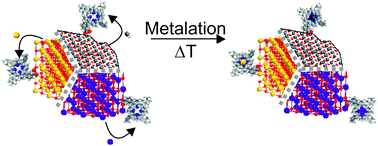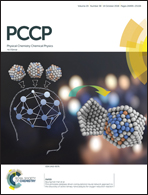Anchoring of carboxyl-functionalized porphyrins on MgO, TiO2, and Co3O4 nanoparticles†
Abstract
Hybrid materials consisting of functional organic molecules on metal oxide nanomaterials are key components in emerging technologies, for example in energy conversion and molecular electronics. In this work, we present the results of a comparative study of carboxyl-functionalized porphyrins on different oxide nanomaterials. Specifically, we investigated the interaction of 5(3-carboxyphenyl)-10,15,20-triphenyl-21,23H-porphyrin (2H-3-MCTPP) and 5(4-carboxyphenyl)-10,15,20-triphenyl-21,23H-porphyrin (2H-4-MCTPP), on MgO, TiO2, and Co3O4 nanoparticles (NPs) using isothermal and temperature-programmed diffuse reflection infrared Fourier transform spectroscopy (DRIFTS). We show that both porphyrins bind to the NPs, yielding stable monolayer films consisting of tilted surface carboxylates. In all cases, anchoring through the carboxylic acid group suppresses self-metalation of the porphyrin unit. Upon annealing, all anchored porphyrin films undergo metalation. The position of the acid group has no major influence on the reactivity. The same is true for the nature of the metal oxide, suggesting that the observed behaviour is general for most anchored porphyrin films on oxide nanomaterials.



 Please wait while we load your content...
Please wait while we load your content...